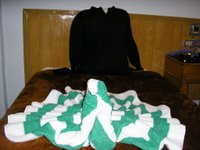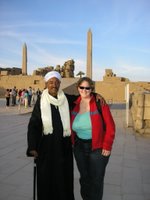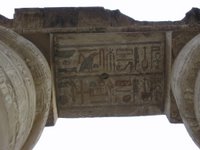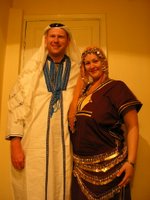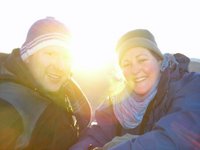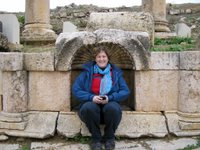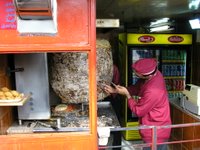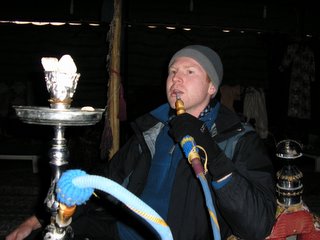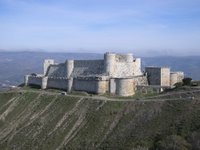Germany – 24th – 29th January 2006
On Tuesday (24th), we caught a flight from Stansted to Frankfurt Hahn. Both airports are located in out-of-the way places, and it took us twice as long to get to and from the airports than the actual flight between countries. Our arrival into Hahn was delayed for an unknown reason, which resulted in us having to queue outside before being able to pass through immigration. The delay meant we also missed our bus to Frankfurt’s Central station, resulting in further queuing outside. By the time we got on the bus we were frozen through and we were trying to guess the temperature. Neither of us came close – it was -7ºC. No wonder we were cold!
The purpose of our visit to Germany is to visit my friend Gitte and her family. I first met the Jakobs through a student exchange to Germany in 1997 and I have been back to stay with them several times. Gitte is now a teacher and lives with her partner, Stefan, just outside Frankfurt. Her parents, Kirsten and Joachim, live several hours away, in a town called Borken.
Our first morning in Germany was a big lie-in. Gitte and Stefan both had to work a half-day, so we did very little while they were at work. The sun was shining and it was a beautiful day when they came home, so Gitte took us to a nearby village for a walk and some sightseeing. The village, Gelnhausen, is the birthplace of Paul Reis, who invented the telephone concurrently with (but independently from) Alexander Graham Bell. It is a very old village and has some lovely buildings, including one with cast-iron cats on the roof. As we walked around Gelnhausen it began to snow. Undeterred, we went to the ruins of a castle built by the German king, Barbarossa (a.k.a Frederick I). Unfortunately, we were unable to enter the ruins so we went back to Gitte’s house.
We had a wonderful evening with Gitte and Stefan, eating a delicious meal and playing Uno. The next morning, none of us felt like doing the dishes so we went out and bought a dishwasher. Gitte went off to school and Stefan took us to Flörsbachtal for some sledding. We passed several hours there, getting covered in bruises and having a great time. For novices, we found the hills quite steep enough, although Stefan assured us they barely counted as hills. Fletch had tremendous trouble NOT hitting trees, fence-posts and the like, whereas I just had trouble staying on the sled. We had a wonderful time.
On Friday, we drove to Borken to spend the weekend with Gitte’s parents. We arrived in the afternoon and spent several hours showing them photos of our trip – there are over 1000 so far! We then had a dinner party.
(Fletch subs in)
Saturday dawned bright and clear and cold. The meals here tend to encourage you to go for a long walk. Thus after extracting ourselves from the breakfast table, we grabbed some sleds and headed to a ‘real hill’ named Weinkopf. We took a delightful stroll through a snowy forest before launching from the top of the hill. There really wasn’t much snow on the ground by this time, but it was still quite icy. The result was a fast and extremely bumpy ride.
We then strolled back through the forest, past some lumberjacks with their chainsaws, to the cars.
Borken was originally a coal-mining town. Brown coal was mined underground until 1988 when an underground explosion killed at least 50 people and closed the mining operations. As a result the mines have been allowed to fill with water from natural springs, creating lakes. Each of the lakes is set-aside for a different purpose. One is for swimming, one is for wind surfing and aqua golf, and a third is currently in the process of filling and will be used for speedboats.
The first lake we visited, Singlis, has a coast guard boat moored in it. Why they decided to stick an old coast guard boat in the artificial lake I’m not entirely sure, but it is now used as a club and for small functions. This lake allowed me my first opportunity to walk on water. The aqua golf intrigued me, but I’d need to return in summer to see how it is played.
The next lake we visited is called Stockelache. In summer, thousands of people descend on Stockelache as it is the main ‘swimming hole’ in the area. When we visited, people were using it as an ice skating ring. Standing on a lake is quite fun, however the occasional growl and groan comes from the ice. The prospect of an icy bath when the ambient temperature is about -4˚C is distinctly distasteful for someone like me who will usually only swim when the temperature is above 35˚C. Thus the wonder of standing on a lake was tempered by the unease of standing on a VERY COLD lake.
We returned home for an afternoon nap before going out to a Greek restaurant for dinner. The experience of choosing food from a Greek menu can be fun anytime. Choosing from a Greek menu when the explanations are in German is much more interesting. I finally recognised gyros and was pleasantly surprised when it came with fried onion and baked potatoes.
After a lovely meal we came home for an espresso and a warm bed.
Today is Sunday and it is a lovely day, inside the house. It’s apparently bitterly cold outside, but we haven’t been tempted to find out. Tomorrow we return to Gitte’s house before flying to Stansted on Tuesday. Till we talk again, take care.
Fletch’s tip for new travellers
Don’t knock long underwear until you have tried it. Then, don’t give it back. (Danke schoen Jakobs)

